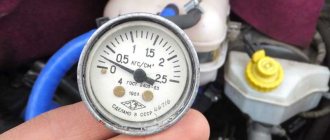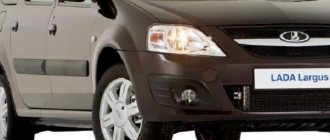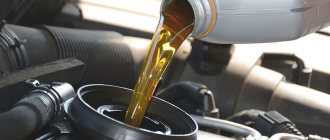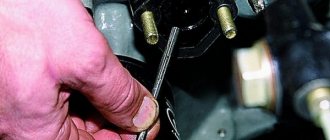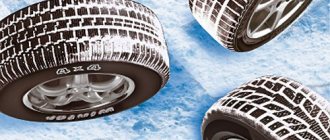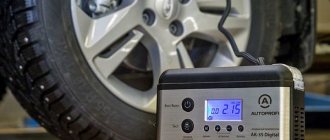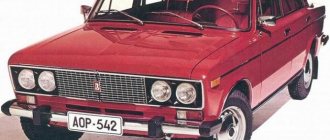Optimal car tire pressure
The main task of car tires is to provide effective traction between the car and the road. With normal air pressure in the tire, the load in the contact patch of the wheel with the road is distributed evenly, due to which tire wear occurs evenly, the car handles well and fuel consumption is within normal limits.
There are three possible scenarios in which the tire pressure will not be optimal:
- Increased pressure (tires overinflated);
- Low pressure (tires underinflated);
- Different pressure in all wheels.
Check the tire pressure with a special tire pressure gauge. This should only be done on cold tires, that is, before leaving the parking lot or garage.
If deviations from the normal pressure are detected in any of the tires (see the table below for what pressure should be in the tires of your passenger car), such a wheel must either be inflated or excess air released from it - that is, the pressure must be adjusted to norm. In one of our articles, we already talked about which car compressor is best for inflating tires.
It is worth noting that the tire pressure in winter should be exactly the same as in summer. But due to the sharp temperature change, in winter, monitoring the air pressure in the wheels needs to be approached more responsibly.
It is better to inflate your tires outside. Also, do not forget to check the tire pressure when there are significant changes in ambient temperature, and if necessary, adjust it:
- if it gets cold outside, the pressure in the tires will decrease,
- and when it gets warmer, it will rise.
It should also be remembered that while the car is moving, the tires heat up, the air in them expands, and the pressure increases, and the handling and braking properties change.
Increased tire pressure
With increased tire pressure, the load at the point of contact of the wheel with the road acts to a greater extent on the central part of the tire tread, thereby causing uneven wear of the tire.
On overinflated wheels, the car brakes worse! This happens because if the tires are overinflated, the contact patch with the road decreases, which means the friction force that keeps the car from sliding decreases. At the same time, the braking distance increases noticeably.
In just twenty minutes of driving, taking turns as aggressively as possible, the pressure in the car’s tires can increase by 0.5 atmospheres. And on long trips at high speed, the pressure in the tires can increase to 4-5 atmospheres. And modern tires are designed for this.
But if the tire has a hernia or cut, it can heat up and explode while driving. But on the road it’s a disaster.
Low tire pressure
Wheels lowered to just half an atmosphere change the behavior of the car and become unusable much earlier than expected. When the pressure is low, the load on the tire surface is distributed unevenly. In this case, the sidewalls of the tire where the tire contacts the road are subject to increased wear.
The sidewalls of flat tires are softer and bend when you turn the steering wheel. The trajectory of the wheel and tire do not match, so the car responds to the steering wheel late.
Moreover, if the tire pressure is reduced, the wheel may even come off during a sharp turn. Therefore, it is very important to regularly check the tire pressure and maintain it within the normal range.
This is especially true in winter, since in cold weather the tire pressure can easily drop by 0.3 (or even 0.5) atmospheres.
It is also worth keeping in mind that low air pressure in the wheels leads to increased fuel consumption. Just in case, we remind you that our website has an excellent selection of tips on how to reduce fuel consumption in a car - be sure to read it, you will probably find something new for yourself.
Different pressure in car tires
The most common situation among drivers is when the pressure in all wheels is different. There can be many reasons, for example:
- Faulty spool valves;
- Uneven tire wear;
- Or perhaps you caught a nail with the wheel.
During emergency braking, in this case, the coefficient of road adhesion between inflated and lowered wheels will be different, which with a high degree of probability will lead to the car skidding or turning across the road.
If the car starts to pull even a little to the side, there is a reason to check how the tires are inflated. And remember that tires don’t last forever. Even very good tires need care.
How is tire pressure measured?
To get an answer to this question, you first need to remember the school physics course for grades 7-8. The internationally recognized measurement system is SI. The basic unit of measurement (U) in this system is Pascal (Pa) = 1N/m2.
There are also derivatives from it:
- 1kPa = 1000 Pa;
- 1 MPa = 1000000 Pa.
For ease of calculation, different units of pressure are used in different spheres of life, the base of which is Pascal. Thus, in meteorology and geology, Bar is used, 1 bar = 105 Pa. To calculate physical phenomena, use indicators equal to the 1st pressure of the air atmosphere on the surface of the earth - 1 atm. = 101325 Pa.
In technical industries, including for calculating tire pressure, they use an indicator that produces a body weight pressure of 1 kg per 1 cm2, i.e. 1kg/cm2. 1 kg/cm2: 1 atm. = 98066.5 Pa, at the same time 1 atm ≈ 1 bar. Due to the widespread use of kg/cm2 in technology and its relationship with atmospheric air pressure, this unit is also called the technical atmosphere.
It is worth noting that UI - kg/cm2 is used to determine tire pressure in domestic vehicles, while non-system UI is used abroad: Bar (bar) or PSI (pound/in2).
Factors requiring adjustment of tire pressure
The point is also that depending on the nature of the movement and the characteristics of the load, different pressure is required. Here are the main factors that must be taken into account when correcting the degree of tire inflation:
- model, make and, accordingly, weight of the car;
- tire size;
- season – cold or warm;
- driving habits and road type;
- driving around the city or on the highway;
- number of passengers in the car;
- engine type: diesel or gasoline.
- presence of cargo in the car;
- wheel type: front or rear.
Tire pressure
You can find information on the recommended value for your model on the gas tank door or in any other place. We present several options in the photo. You need to be guided not by advice, but by the manufacturer’s recommendations. They are indicated, as a rule, for a temperature of 22◦C, that is, summer time. The pressure in winter tires R16, as well as R14 and R15, is reduced to improve the grip of the wheels on the road, in other words, they make the movement heavier, which is very convenient in snow and ice.
The nature and measures to reduce road safety are well illustrated by the table, which reflects changes in the nature of the passive safety of a passenger car.
Tire pressure measurement
Table 1. Effect of tire pressure on safety and wear resistance:
| Changing the pumping indicator | Nature of influence |
| Normal | Vehicle safety and controllability Sufficient mileage Normal fuel consumption |
| — 0.5 bar | An increase in tread wear by 20%, the possible mileage is approximately reduced by 8 thousand km. |
| — 1 bar | Dangerous driving parameters, additional fuel consumption. |
| — 1.5 bar | The car may lose control of the road |
| — 2 bars | Braking distance on wet asphalt increases to 11 m. |
Note! A wheel that has been used in a poorly inflated condition may explode when the parameters are restored, and this can happen right on the road.
By the nature of wear, you can determine whether increased or decreased parameters usually occur on your model. This is well illustrated in the photo.
Standard wheel parameters and, accordingly, tread inflation are usually assessed at a summer temperature of 22°C; in cold weather, the parameters decrease, and with increased load and driving on the highway, they increase. Please note that the front wheels are pumped up 10% more, this is done so that the rear of the front-wheel drive model does not skid, and it maintains directional stability better.
Inflating tires on a car
With all-wheel drive, the wheels are inflated equally. This also directly depends on the weight distribution parameter. If it is 50*50, it is inflated to equal values, if there is a weight distribution or the vehicle is loaded, then the rear wheels are inflated more for freer movement.
In cold weather, for driving on a snowy road, it is recommended to increase the pumping; if driving on ice is meant, it is reduced. Thus, protectors are a completely reliable system for controlling directional stability, but only if you have certain knowledge that depends on a number of parameters. To illustrate what has been said, we present tables.
Table 2. The degree of inflation in wheels with and without a load using the example of some brands:
| Model and modification of a passenger model | Tire sizes | Inflation level | ||||
| Front | Rear | Standard | With load | |||
| Front | Rear | Front | Rear | |||
| Lanos 1.5i SE-SX & Auto | 175/70 R13 T | 2,2 | 2,2 | 2,2 | 2,2 | |
| Matiz 0.8i S-SE & Auto | 145/70 R13 T | 1,9 | 1,9 | 2,1 | 2,3 | |
| 155/65 R13 T | 1,9 | 1,9 | 2,1 | 2,3 | ||
| Nexia 1.5i GL & Auto | 175/70 R13 T | 2,6 | 2,1 | 2,6 | 2,1 | |
| Nexia 1.5i GLX-GTX & Auto | 185/80 R13 T | 2,2 | 2,4 | 2,2 | 2,4 | |
| VAZ 2104 | 165/80 R13 T | 1,6 | 2,1 | 1,7 | 2,3 | |
| 175/70 R13 T | 1,6 | 2,2 | 1,7 | 2,2 | ||
| VAZ 2108/09/99 | 165/80 R13 T 175/70 R13 T 155/80 R13 T | 1,9 | 1,9 | 2,0 | 2,0 | |
| 1,9 | 1,9 | 2,0 | 2,0 | |||
| VAZ 2110 and Lada Priora | 175/70 R13 T | 1,9 | 1,9 | 2,0 | 2,0 | |
| 175/65 R14 T | 2,0 | 2,0 | 2,1 | 2,1 | ||
| 185/60R14T | 2,0 | 2,0 | 2,1 | 2,1 | ||
The pressure in R15 tires in winter should be 2.3 and 2.6 (185/65 R15 - 2.4 and 2.6), in R16 - 2.3-2.8, but these values are advisory, exact numbers are always are unique to each model and are usually written on the fuel tank cap. However, it does not indicate what parameters should be in winter. Let's consider this issue in more detail.
Tire pressure characteristics
How to calculate the degree of tire inflation in winter, based on the manufacturer’s official data. Of course, it is better to use the official recommendations of the car manufacturer or service, but you can be guided by general theoretical knowledge.
The general theory is related to the physics of gaseous media. What does it mean? As the temperature drops, the degree of inflation also decreases, so to improve cross-country ability it is necessary to inflate the tread. You can adhere to the following recommendations:
- when the temperature decreases, to maintain or improve the tire's cross-country ability, the tire should be 0.1-0.2 units more;
- if you need to maintain controllability in icy conditions, the parameters remain the same as in the summer, to a lesser extent this applies to the R16;
- if the weight distribution is the same, the products are inflated equally, while at maximum load the rear group is inflated by 0.2;
- in R14 tires the pressure is within 2.0 bar, in other sizes, respectively, less or more (R16);
- You can pump up the wheels that are driving more.
When does tire pressure need to be adjusted?
If you look at the documentation for use, you can find advisory information from manufacturers. She clarifies when it is necessary to adjust the number of atmospheres in the chambers. This should generally be done when driving frequently at high speeds (above 160 km/h). To improve vehicle controllability, it is necessary to increase the nominal value by 0.2-0.4 Bar. However, such advice is of little relevance for everyday driving, especially in Russia, where there are no high-speed highways.
For a long trip on snowy roads, the value, on the contrary, should be reduced by 10-15% from that recommended by the manufacturer. Thanks to the adjustments made, it will be possible to significantly improve the adhesion of car wheels to the road surface.
In addition, you should take into account the influence of ambient temperature - the colder it is outside, the less air pressure in the tires. Therefore, the value needs to be increased by 0.2 Bar.
How temperature affects tires
Fuel consumption, the load on the chassis and the frequency of purchasing new tires depend on what pressure should be in R19 tires. When the air temperature outside increases, the pressure in the tires of the car increases along with it. And vice versa - the colder it is outside, the lower this value. There is a table for changing the optimal pressure in R19 tires depending on the air temperature:
| Outdoor air temperature | Pressure |
| +25 degrees | increases by 0.8 bar |
| -25 degrees | decreases by 0.8 bar |
These indicators are presented for a passenger car with a partial load (minimum number of passengers and cargo in the trunk). When fully loaded, the discrepancy between the indicators will increase. Standard indicators for this wheel size vary depending on the car model and range from 2.2 to 2.7 atm.
Tire pressure measuring device
You should also take into account that when inflating tires indoors (service station, garage), you need to increase the atmospheric pressure in the tires in winter by 0.2 bar. This will help compensate for temperature differences. In summer, this rule does not need to be followed, because there is almost no temperature difference.
Also, if you constantly need to pump up R19 wheels, pay attention not only to temperature changes, but also to:
- degree of wheel wear;
- nipple fastening;
- tubeless valve condition;
- quality of the air mixture in the chamber.
What is the impact of maintaining tire pressure parameters?
Incorrect air pressure in the chambers can result in unpleasant and dangerous consequences.
Over-inflated tires can:
- while driving, cause strong vibration, shaking, passengers and the driver will feel every pebble that gets under the wheel;
- cause damage to the rubber, because a heavily inflated wheel is not able to smoothly absorb shock;
- contribute to wear of the suspension or its individual elements;
- cause strong noise inside the cabin, which will cause severe discomfort to passengers and the driver of the vehicle;
- make the steering wheel move easier, which in case of an emergency can lead to an accident.
In addition, due to high pressure, the contact area between the rubber and the road surface decreases, as a result, the tire wears unevenly and the tread pattern is erased.
Pressure below the recommended value is also fraught with unpleasant consequences:
- leads to increased fuel consumption;
- accelerates tire wear;
- the tire begins to heat up very much when driving, which is why it can burst at the most inopportune moment;
- the car loses maneuverability, so control becomes more difficult;
- the angle of the wheel changes, which can lead to the vehicle skidding when cornering.
Tire pressure is an important parameter for safe driving that requires special attention. In order not to spend money on a set of new tires and reduce the risk of an accident, it is necessary to regularly measure this parameter and, if necessary, make adjustments.
What will happen to the car if the recommended pressure is neglected?
Under no circumstances should you inflate your car's wheels to the level indicated on the tire beads. This parameter refers to the limit values. The decision to pump a tire to the limit can cost you life and health - with such pressure, the tire should burst, unable to withstand the load. Therefore, it is not recommended to pump tires up to 50 psi. Try not to pump the wheel above the normal level mentioned in the table - you will change the dynamics of the car and lose control. Excessively tight tires lose traction, which leads to longer braking distances. In addition, in this case, the load on the car will increase - the suspension will receive more impacts from potholes, and hitting a speed bump will result in serious repairs.
Give up the idea of reducing the required pressure value for the sake of increased cross-country ability of the vehicle. Yes, this scheme works as it should and is recommended in total off-road conditions, however, a car with half-flat tires (relative to the normal indicators recorded in the table) overuses 0.5-1.5 liters of fuel for every 100 kilometers.
Reasons for low tire pressure
The simplest and most common cause of reduced air pressure in wheels is a broken nipple. Such a small element at first glance greatly influences the optimal performance of tires, so few people pay attention to it. According to the regulations, the nipple must be replaced every three months, but most car owners do not follow this rule, but carry out the replacement along with the seasonal change of tires.
The fragility of nipples lies in the fact that they have a weak spring mechanism that quickly fails. At the same time, many manufacturers make spool sealant from low-quality rubber, which leads to the release of air.
Another factor that influences the fact that the recommended tire pressure of a car drops in winter is the rubber tubeless valve. It should be changed every time the tires are renewed. But not everyone adheres to these recommendations, but it is worth doing at least every fall. During the cold season, a tubeless valve loses its flexibility due to frost. In addition, contact with the rim is reduced. All this reduces the tightness, which allows air to escape from the wheels.
The pressure is largely influenced by the seat of the rim. In winter, the rim is often stained with dirt, covered with various foreign inclusions and particles, and sealant residues may appear on it. And if all this is not kept clean, then the tire may lose flexibility, and accordingly, the value of the atmosphere decreases. Other provoking factors may include outdated tires, tube wheels, poor-quality air mixture, etc.
Effect of tire pressure
First of all, if the tire pressure is incorrectly set, the contact patch of the rubber tread with the road changes and worsens the traction properties of the wheel. Manufacturers initially design their tires for use in the right conditions, and changing the recommended parameters usually leads to worse dynamics.
Low pressure
High blood pressure
What tire pressure should you maintain and why?
First of all, modern tires today are tubeless. So, this type of tire is highly sensitive to pressure. If the pressure decreases by no more than 1/5 or increases by 20%, tire wear increases by a third, safety suffers, the load on chassis parts also increases significantly, etc.
It is important to understand that even if the tire does not have punctures or damage, or there are no disc defects leading to loss of pressure, this indicator still changes over time as a result of temperature changes, when driving over potholes, uneven surfaces, etc.
In other words, tire pressure drops. For this reason, it is important to know what pressure should be in a car’s tires in winter, how to inflate summer tires, as well as how deviations from the norm affect tire wear, car stability, etc.
High pressure - negative effects of overinflated wheels
Rubber does its job well to the best of its ability, when the tread lies on the road with its entire plane and quite tightly. If the pressure is too low, the ride is formed on the side portions of the tread alone. If the pressure is too high, the tire blows out and the car drives only on the middle part. This is what causes the main negative aspects of this effect.
The contact of the rubber with the road is minimal, and the arrangement of the tread parts is unnatural for normal rubber. Therefore, the properties of a completely high-quality and good tire are lost. It is for this reason that many drivers buy expensive tires and write bad reviews because they do not meet expectations. Over-inflated tires cause the following unpleasant features when traveling and operating your car:
- excessively rough ride, presence of constant jolts and shaking inside the car due to hard tires;
- high pressure does not allow the tire to absorb unpleasant moments of the road, provide additional or even primary shock absorption;
- the tread lies on the road in an unusual position, which causes a lack of positive qualities of the tire;
- rubber wear occurs only in the central part, which deforms and damages the tire much faster;
- car control suffers greatly, since the tread cannot efficiently perform its tasks on a hard cord;
- the smaller the radius and height of the tire tread, the more clearly the driver will feel all the troubles of high pressure;
- the lack of shock absorption also causes a lot of wear on the disc, because it absorbs almost all impacts.
As you can see, some symptoms of overinflated tires are similar to those of too low tire pressure on a car. Therefore, it is much easier and more profitable to adhere to the average weighted level of inflation of each wheel. It is also important to ensure that the pressure is even. On the rear axle of a front-wheel drive car, a pressure drop of 0.1-0.2 atmospheres can be allowed, but this should also be symmetrical.
You can view the required tire pressure parameters in the operating instructions for your vehicle. This document provides weighted average recommendations that will help you operate your vehicle reasonably well without increasing fuel consumption. However, if you have changed wheel sizes, then the factory specifications no longer apply to your situation.
Tire pressure in winter and summer
So, when choosing tires, you need to be able to decipher tire markings, take into account speed indexes, tire loads, etc. Please note that in order to understand what pressure should be in the tires of a car, you need to take into account that such pressure depends not only on the tire itself, but also on the specific car.
Pressure recommendations are indicated by the manufacturer himself. In other words, if you install the same tires on different cars (same manufacturer, size, etc.), the recommended tire pressure may differ depending on the car.
The fact is that when a manufacturer indicates the so-called permissible standard tire sizes for a specific make and model of a car, the weight of the car and a number of other parameters are taken into account separately. For ease of understanding, at the end of the article there will be a table of tire pressures by car brand.
- Let's move on. If we talk about the pressure in a car’s tires in general, it should be borne in mind that the main task of a tire is to have the most effective grip on the road.
If the air pressure is normal, then the loads in the tire contact patch with the road will be distributed evenly. In this case, tire wear also occurs evenly, all technical characteristics and parameters of the tire are fully realized.
Maintaining the recommended tire pressure means that the car is easy to drive, cornering stability is normal, there is no unnecessary noise from the wheels when driving, braking performance is at the proper level, fuel efficiency and comfort are maintained.
In case of deviations, 3 options are possible:
- blood pressure is increased;
- blood pressure is low;
- different tire pressures;
In the case when the tires are overinflated, and when the tires are underinflated, they wear out severely, a decrease in comfort occurs, deterioration in handling, etc. To check the tire pressure, a special tire pressure gauge is used. Also note that some modern cars have a tire pressure monitoring system.
The solution independently determines the pressure indicator and notifies the driver of deviations from the norm. Such equipment can be installed standard from the factory; the option of self-installation is also allowed.
If there is no such system, check the tire pressure with the tire pressure gauge mentioned above. Please note that this should only be done on cold tires. If the pressure is higher than normal, the wheel needs to be deflated a little by releasing the air. If the pressure drops, the wheel needs to be pumped up.
The main thing is to bring the tire pressure back to normal (for all wheels). By the way, for inflation you can use a hand or foot pump (cheap and inconvenient) or a car compressor for inflating tires (more expensive and as comfortable as possible).
If we consider tire pressure in winter, tires need to be inflated in the same way as summer tires. As an example, if for 185/55 R15 tires the manufacturer of a particular car recommends pumping 2.1 atmospheres, then both summer and winter tires need to be pumped this way.
The only thing you need to take into account is that in winter there are more frequent temperature changes. It turns out that in winter you need to constantly monitor the air pressure in the wheels, and also make allowances for the fact that temperature fluctuations can lead to rapid deviations from the norm.
Simply put, the owner inflated the tires as recommended. However, when it gets colder outside, the tire pressure will be reduced. If warming occurs, then the pressure rises.
For this reason, it is necessary to check the pressure on winter as well as summer tires if the average daily temperature fluctuates by more than 4-5 degrees Celsius (for example, during the day +27, but at night the temperature dropped to +15).
How to check the tire pressure of a vehicle
The check is carried out using a special device - a pressure gauge; it must be checked before the car starts moving and always on a cold tire. You can buy a pressure gauge at your nearest automotive store. Pressure gauges come in several varieties: pointer, mechanical and electronic; the differences are only in the principle of operation, and their readings may vary slightly. Which type of device to buy depends on the thickness of the wallet. Any compressor or pump that is used to inflate wheels is equipped with a pressure gauge. It can also be used to measure tire pressure.
If you checked the pressure with a pressure gauge and found that the readings are far from the required ones, and there is nothing to inflate the tire with, do not despair, now most gas stations are equipped with compressor units, using which you can easily and quickly inflate the tires (this is an absolutely free service). If you accidentally overinflated the wheel, simply press the nipple and release the “extra” air. Driving for a long time in a car whose tires are over-inflated, or, conversely, not inflated at all, is fraught with unpleasant consequences.
When a car's tires are poorly inflated (below the required level), this, first of all, quickly wears out even “fresh” tires, and secondly, it leads to an increase in fuel consumption. Why is this happening? It's simple. Due to weak inflation, the tire is subject to deformation, which leads to an increase in resistance and rapid heating of the rubber.
What is most important is that only the edges of the wheel wear out, and with normal inflation, rubber wear occurs evenly, since the entire surface of the tire is in contact with the road surface. The most unpleasant thing is that the car becomes virtually uncontrollable, directional stability is lost, and as it moves, the wheels can spontaneously “disassemble”, the vehicle stops turning normally, the braking distance increases, etc.
To drive 20,000 kilometers on poorly inflated tires, you will need an additional 540 liters of gasoline, which will add up to a tidy sum.
By overinflating your tires, you will also experience deterioration in your car's handling, as the tires' grip on the road decreases. The load on the suspension also increases, which seriously reduces their service life, wear occurs and the suspension fails.
Constantly driving on tires with high pressure leads to wheel deformation and wear of the central part of the tire. Vehicle handling becomes more rigid, and long-term use of a car with such tires will cause many problems.
This can be easily avoided by knowing a simple rule:
Pressure adjustment should be done on “cold” tires.
The vehicle should stand motionless for several hours (during driving, the tires heat up, which leads to an increase in pressure, this is worth taking into account, because the recommended pressure is indicated for unheated tires).
Winter tires
A few words about winter tires. When inflating tires in a heated garage in winter, remember that the pressure can be exceeded by 0.2 atmospheres. This is correct for regular winter tires and their studded variants. Why exceed the norm? It's simple: when leaving a warm garage, the tires gradually cool down, therefore, the pressure in them drops.
Have you read the article but still have some unclear points? It's time to contact our specialists (numbers below), who will answer all your questions on this topic.
When you need to lower your tires a little
In some cases, there are recommendations to slightly lower the tire pressure than specified in the recommendations. There are two such cases:
- In winter, if the pressure is a little less, then better traction occurs. But as the temperature changes, the internal volume in the tire also changes.
- The most popular use for slightly lowered wheels is off-road driving. In this case, the wheels will act on the principle of tracks. Which will increase cross-country ability.
But it is difficult for an inexperienced driver to determine by what indicators to reduce the pressure. Therefore, we do not recommend experimenting.
Conclusion: the pressure in car tires must be checked regularly, maintained at the level recommended by the manufacturer, and weather and road conditions taken into account. This will extend their life and help make your ride safer.
Dependence of pressure characteristics on wheel size
Naturally, the pressure of different tire sizes will be different. Domestic classic cars with size R13 have the lowest performance. Modern Russian models and foreign cars move on R15 wheels, in which the rating exceeds 2 atm. These parameters do not change either in winter or summer, except in extreme cases when the pumping level is changed to drive along a problem section of the road. The summary table shows more precise figures of what pressure should be:
| Wheel size | Car make and model | Front wheel pressure, atm | Rear wheel pressure, atm |
| 155/80/ R13, 165/80/ R13, 175/70/ R13, 185/60/ R13 | VAZ 2101-2107 | 1,6-1,7 | 1,9-2,1 |
| 155/80/ R13, 165/70/ R13, 175/70/ R13, 185/60/ R13 | VAZ 2108-2115 | 1,9 | 1,9 |
| 175/65/ R14, 175/70/ R14, 185/60/ R14, 185/70/ R14 | Kalina, Priora, Granta, Renault Logan | 2,0-2,2 | 2,0-2,2 |
| 185/60/ R15, 185/65/ R15, 195/50/ R15…195/70/ R15, 205/65/ R15, 225/79/ R15, | Vesta, Largus, Ford Focus, Nissan Almera, Toyota Avensis, Corolla, Mercedes C-Class, BMW 1-3 series, Audi A4-A7 | 2,3-2,8 | 2,3-2,8 |
When the car is fully loaded, the pressure should be increased to maximum values. More precise recommendations from manufacturers are indicated on the plates on the B-pillar on the driver's door side. When installing wheels of non-standard sizes on a car, it is necessary to adjust the inflation according to the parameters of the new tires. The table below will help you determine what tire pressure to set.
